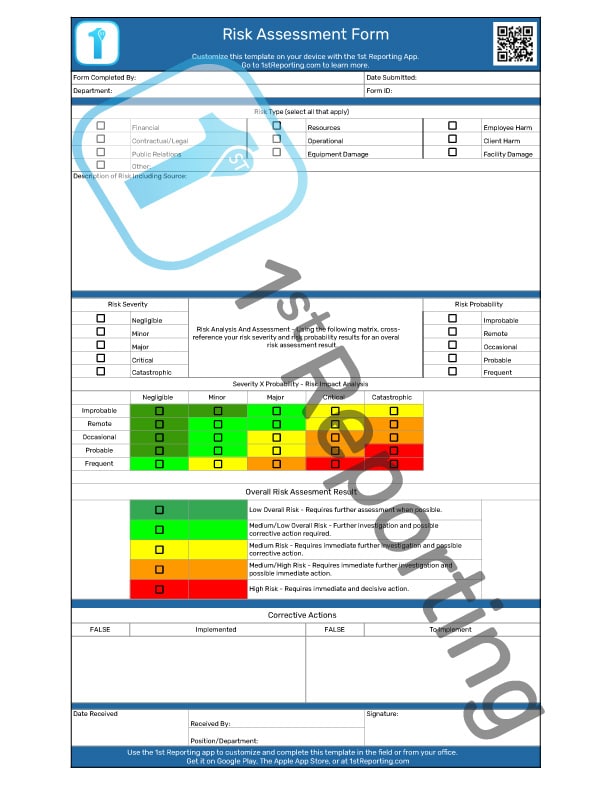
Incidents are unfortunate, no matter the industry. And having an incident wind up going to court can be a headache that even the staunchest business person would cringe at the thought. And even though your organization filed all the appropriate forms and reports, it may still come to pass that a judge decides further ‘in-house’ documents ought to go into the light. In particular, your company’s internal documentation, like an incident report, may have the spotlight turned in its direction. But, can they do that?
Suppose a judge deems that internal documents such as incident reports would be valuable to a court case. In that case, the judge may very well allow a subpoena to bring forth the information or reports for presentation in a court of law. However, the law differs from state to state.
With the possibility that your internal incident reports could face the scrutiny of the courtroom, there are a few things you and your company can do to prepare. But, first, let’s briefly go over some of the industries at the highest risk of exposure.
We’ll also discuss confidentiality and the pros and cons of your internal incident report facing a courtroom. So, stick with us, and let’s dive into incident reports in court.
What Industries Have The Highest Risk For Businesses?
If you’re wondering whether your business exposure is high-risk, we need to define what a high-risk exposure is. When it comes to courtroom exposure from incidents within your company, high risk is where the likelihood of an incident proceeding to legal action is high.
Most people think that to fit into this category, you must work in a dangerous environment. According to the National Safety Council, the most hazardous industries in 2019 were:
- Construction – the most workplace deaths in 2019
- Government – the most lost-time accidents
- Agriculture, Forestry, Fishing, And Hunting – the highest death rate per 100k workers
- Transportation And Warehousing – the most lost-time accidents per 100k workers
Risk exposure doesn’t’ stop with dangerous work environments. And just because many injuries occur within an industry doesn’t mean there is a high litigation percentage.
One of the most notorious industries for incidents turning into court cases is that of the medical care industry. And it isn’t like the medical industry faces dangers like those found in some other industries. However, with a raging pandemic in 2020, there is a case to argue that the medical industry is more dangerous. That is, more dangerous than the general public realized before the pandemic.
Why Is The Medical Industry At Such High Risk?
The medical industry is notorious for a large volume of incidents. The reason is the complexity of medical care often results in minor accidents. From accidentally prescribing incorrect dosages to slips and falls to accidents with needles, wheelchairs, medical equipment, and more than we can mention, the medical industry has more potential for incidents than we care to admit.
Consider the numbers for a moment. Physician’s Weekly made a fascinating point in an article from as recently as January of 2018. The article mentions how Dr. Bob Wachter, a patient safety expert at San Francisco General, noted that the hospital receives about 20,000 incident reports per year. That’s 54.79 incidents per day.
Considering these numbers, Dr. Wachter notes that an estimated 80 minutes per incident report is an acceptable estimation for the length of time needed to review the incident with a committee. Even if we took this number down to 60 minutes, that would be 60 hours per day of incident report reviews for a single hospital. The staffing requirement to oversee an incident reporting system of this magnitude is staggering.
By The Numbers
When we consider the numbers, it doesn’t become a surprise that most incident reports get filed away forever, never to see the light of day. And that means no resolutions for incidents either. Not unless the incidents are severe enough to raise questions.
Now consider what happens down the road when a person involved with an incident decides legal action is required? A highly detrimental situation for the facility sitting on an incident report with zero actions taken to correct the accident or prevent further recurrence.
So, how do we get around having so many incident reports with no action? We streamline the system and make incident reporting lighting fast and instantly accessible, for starters. Using an especially purposed reporting system like 1ST Incident Reporting offers is the first step to the solution I would put in my facility if it were up to me.

A lawyer takes notes while on the phone with his client in this file photo—image by espartgraphic from Pixabay.
What About the Confidentiality Of Internal Documents? Are Incident Reports Confidential?
Depending on where your company operates, some states may have certain conditions that deem the incident report a confidential document. Where this is the case, a nurse (to use the medical industry again as our example) cannot have an incident report used against them. However, under certain conditions, even if there appears to be the security of confidentiality, a judge may allow incident report documents to be used against a defendant.
Ergo, confidentiality is only as good a defense as the law will allow. And that is debatable sometimes, so business beware.
The Pros And Cons Of Incident Reports Making It To Court
We’ve talked about the exposure risk of having internal documents land in court. But we haven’t talked much about the potential benefits. Let’s look at both the pros and cons of incident reports and their availability in a court case.
| Pros Of Incident Reports for Court | Cons of Incident Reports for Court |
| Backup information can prove a company implemented action to the fullest extent of its legal obligations. | Can expose company management negligence |
| Documents information that could be forgotten by witnesses | Can expose staff and worker negligence |
| Shows overall company organization and due diligence (in terms of creating an incident report at least) | May provide evidence of improper or a lack of procedures. |
If an incident does wind up in court, it isn’t necessarily a bad thing. There are several reasons why an incident report may seem positive or negative, depending on the situation.
In the above table, we can see the three primary pros and cons of incident reports ending up in a courtroom. The pros of having an incident report (assuming proper completion of the document) are many. The incident report might prove the organization was not at fault and acted to the best of its ability to resolve the incident. The document can provide information that was previously forgotten by witnesses. The incident report also shows a courtroom that the reporting process of the organization is well and good.
Regarding the cons of an organization having an internal incident report surface in the courtroom, there are also several items to discuss. First, the organization’s current management may find exposure if reported notes reveal negligence in management practices. Second, and more likely, a staff or worker is shown negligent or at fault. These first two issues that may arise can expose individuals within an organization (assuming there is damning evidence recorded on the said report).
Lastly, the incident report may expose the organization as a whole if no individuals are to blame for the current predicament. If an organization has any faults in its reporting structure, it may find relevance in a court case, much to the defendant’s chagrin.
The Final Verdict
We may find incident reports to seem futile in situations like a busy hospital unless there is funding to implement reporting solutions that drive positive results properly. However, incident reporting must continue to find, assess, and resolve hazards in the workplace.
Many possible scenarios could arise for incident reports winding up in court. But the point is that depending on the situational particulars, an incident report can save or condemn a person or organization if it enters the courtroom.
How do we limit our personal and organization’s exposure to risk?
- Limit risk by implementing appropriate incident reporting practices in your organization.
- Train staff to appropriately respond to incidents.
- Train staff to appropriately complete incident reports.
- Understand your organization’s legal responsibilities in your state or province.
- Consult a lawyer.
- Use an efficient and effective reporting solution like that offered by 1ST Incident Reporting.
Disclaimer: This article does not constitute legal advice. We strongly recommend you seek legal advice from a qualified professional to understand your rights and obligations.



